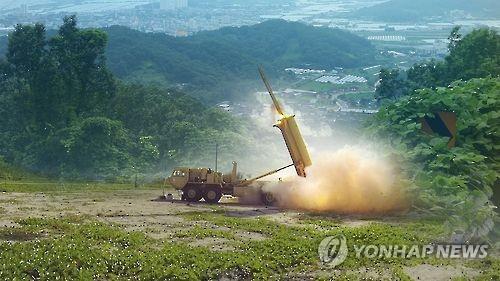- California Assembly OKs highest minimum wage in nation
- S. Korea unveils first graphic cigarette warnings
- US joins with South Korea, Japan in bid to deter North Korea
- LPGA golfer Chun In-gee finally back in action
- S. Korea won’t be top seed in final World Cup qualification round
- US men’s soccer misses 2nd straight Olympics
- US back on track in qualifying with 4-0 win over Guatemala
- High-intensity workout injuries spawn cottage industry
- CDC expands range of Zika mosquitoes into parts of Northeast
- Who knew? ‘The Walking Dead’ is helping families connect
Experts divided over THAAD’s effectiveness in countering N.K. missiles
SEOUL, July 14 (Yonhap) — South Korea and the United States have confirmed the site for deploying an advanced U.S. missile defense system, but disagreement still lingers over its capability to effectively deter North Korea’s missile threats, experts here said Thursday.
The allies said Wednesday that they have picked the southern county of Seongju, about 219 kilometers southeast of Seoul, to deploy the Terminal High Altitude Area Defense (THAAD) system by the end of 2017, a move aimed at countering North Korea’s growing nuclear and missile threats.
Seoul’s defense ministry said that the location is optimal, given that the site is suitable for military operations and is sparsely populated.
“The placement of the THAAD system in Seongju would help more firmly secure the safety of our people living in two thirds of South Korea’s territory while dramatically increasing our ability to defend key state assets … and the South Korea-U.S. alliance forces,” Yoo Jeh-seung, deputy defense minister for policy, told a press conference.
As an integral part of the U.S.-led missile-defense system, THAAD is designed to shoot down a ballistic missile at altitudes of 40 to 150 km in its terminal phase of flight using a hit-to-kill method.
The government said that as THAAD missiles have a maximum range of 200 km, the system, if deployed, is capable of protecting up to southern Gyeonggi Province, which surrounds Seoul.
It said THAAD missiles are capable of intercepting incoming North Korean missiles targeting a U.S. base in Pyeongtaek, some 160 km northwest of Seongju county, home to U.S. Forces Korea (USFK)’s new headquarters.
But experts are divided over whether the THAAD battery could effectively shoot down North Korean missiles with critics arguing that the system’s capability has not been fully confirmed.
“At a simulation test, if North Korea launches a medium-range Rodong missile near Mount Paekdu (located on its border with China), targeting Pyeongtaek, it is found that the THAAD missile may not be capable of intercepting it,” said Chang Young-keun, a professor at Korea Aerospace University.
If placed at Seongju county, the anti-missile system would also not able to provide protection for Seoul and its adjacent areas, where about 47 percent of the 50 million total South Koreans are living, raising questions about whether the decision on the site was well-made.
The South Korean military said that it will relocate Patriot PAC-3 missiles to form another layer of missile defense along with the THAAD battery in a bid to protect the capital and its adjacent metropolitan areas.
Supporters of the system, on the other hand, said that it will help protect lives and assets in the face of North Korea’s evolving nuclear and missile threats.
“There is a controversy over the THAAD system’s effectiveness, but the possibility itself that the system can intercept the enemy’s missiles serves as a deterrent against (North Korea),” said Yang Wook, a senior researcher of the Korea Defense and Security Forum.
North Korea has ceaselessly developed its nuclear weapons and missiles in defiance of international condemnation. The North has fired off ballistic missiles while claiming that it had succeeded in developing a nuclear warhead small enough to be put on a missile.
It claimed the successful launch of the Musudan intermediate-range ballistic missile last month, saying that it has the capacity to strike U.S. forces in the Pacific region.
“A missile defense system is not yet a perfect technology, but it is meaningful that the THAAD system can provide protection for South Koreans at any rate,” said Kim Sung-kurl, a research fellow at the Korea Institute for Defense Analyses. “In addition, from the perspective of the Seoul-Washington alliance, we cannot reject the U.S. move to bring the system here.”
Experts said that the selection of the southern county would also make it difficult for North Korea to target the THAAD battery with its new high-caliber multiple rocket launchers.
With a range of 200 km, the 300-mm-caliber multiple rocket launchers have large areas of South Korea within their range, but cannot reach Seongju.









![일본 사도광산 [서경덕 교수 제공. 재판매 및 DB 금지]](http://www.koreatimesus.com/wp-content/uploads/2024/07/PYH2024072610800050400_P4-copy-120x134.jpg)


